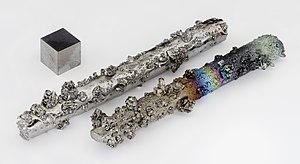Template:Infobox tungsten
Jump to navigation
Jump to search
[[Category:Template:Pagetype with short description]]
 | |||||||||||||||||||||||||||||||||||||||||
| Tungsten | |||||||||||||||||||||||||||||||||||||||||
|---|---|---|---|---|---|---|---|---|---|---|---|---|---|---|---|---|---|---|---|---|---|---|---|---|---|---|---|---|---|---|---|---|---|---|---|---|---|---|---|---|---|
| Pronunciation | /ˈtʌŋstən/ | ||||||||||||||||||||||||||||||||||||||||
| Alternative name | wolfram, pronounced: /ˈwʊlfrəm/ (Template:Respell) | ||||||||||||||||||||||||||||||||||||||||
| Appearance | grayish white, lustrous | ||||||||||||||||||||||||||||||||||||||||
| Standard atomic weight Ar, std(W) | Template:Val[1] | ||||||||||||||||||||||||||||||||||||||||
| Tungsten in the periodic table | |||||||||||||||||||||||||||||||||||||||||
| |||||||||||||||||||||||||||||||||||||||||
| Atomic number (Z) | 74 | ||||||||||||||||||||||||||||||||||||||||
| Group | group 6 | ||||||||||||||||||||||||||||||||||||||||
| Period | period 6 | ||||||||||||||||||||||||||||||||||||||||
| Block | d-block | ||||||||||||||||||||||||||||||||||||||||
| Electron configuration | [Xe] 4f14 5d4 6s2[2] | ||||||||||||||||||||||||||||||||||||||||
| Electrons per shell | 2, 8, 18, 32, 12, 2 | ||||||||||||||||||||||||||||||||||||||||
| Physical properties | |||||||||||||||||||||||||||||||||||||||||
| Phase at STP | solid | ||||||||||||||||||||||||||||||||||||||||
| Melting point | 3695 K (3422 °C, 6192 °F) | ||||||||||||||||||||||||||||||||||||||||
| Boiling point | 6203 K (5930 °C, 10706 °F) | ||||||||||||||||||||||||||||||||||||||||
| Density (near r.t.) | 19.3 g/cm3 | ||||||||||||||||||||||||||||||||||||||||
| when liquid (at m.p.) | 17.6 g/cm3 | ||||||||||||||||||||||||||||||||||||||||
| Heat of fusion | 52.31 kJ/mol[3][4] | ||||||||||||||||||||||||||||||||||||||||
| Heat of vaporization | 774 kJ/mol | ||||||||||||||||||||||||||||||||||||||||
| Molar heat capacity | 24.27 J/(mol·K) | ||||||||||||||||||||||||||||||||||||||||
Vapor pressure
| |||||||||||||||||||||||||||||||||||||||||
| Atomic properties | |||||||||||||||||||||||||||||||||||||||||
| Oxidation states | −4, −2, −1, 0, +1, +2, +3, +4, +5, +6 (a mildly acidic oxide) | ||||||||||||||||||||||||||||||||||||||||
| Electronegativity | Pauling scale: 2.36 | ||||||||||||||||||||||||||||||||||||||||
| Ionization energies |
| ||||||||||||||||||||||||||||||||||||||||
| Atomic radius | empirical: 139 pm | ||||||||||||||||||||||||||||||||||||||||
| Covalent radius | 162±7 pm | ||||||||||||||||||||||||||||||||||||||||
| Spectral lines of tungsten | |||||||||||||||||||||||||||||||||||||||||
| Other properties | |||||||||||||||||||||||||||||||||||||||||
| Natural occurrence | primordial | ||||||||||||||||||||||||||||||||||||||||
| Crystal structure | body-centered cubic (bcc) | ||||||||||||||||||||||||||||||||||||||||
| Speed of sound thin rod | 4620 m/s (at r.t.) (annealed) | ||||||||||||||||||||||||||||||||||||||||
| Thermal expansion | 4.5 µm/(m·K) (at 25 °C) | ||||||||||||||||||||||||||||||||||||||||
| Thermal conductivity | 173 W/(m·K) | ||||||||||||||||||||||||||||||||||||||||
| Electrical resistivity | 52.8 nΩ·m (at 20 °C) | ||||||||||||||||||||||||||||||||||||||||
| Magnetic ordering | paramagnetic[5] | ||||||||||||||||||||||||||||||||||||||||
| Magnetic susceptibility | +59.0·10−6 cm3/mol (298 K)[6] | ||||||||||||||||||||||||||||||||||||||||
| Young's modulus | 411 GPa | ||||||||||||||||||||||||||||||||||||||||
| Shear modulus | 161 GPa | ||||||||||||||||||||||||||||||||||||||||
| Bulk modulus | 310 GPa | ||||||||||||||||||||||||||||||||||||||||
| Poisson ratio | 0.28 | ||||||||||||||||||||||||||||||||||||||||
| Mohs hardness | 7.5 | ||||||||||||||||||||||||||||||||||||||||
| Vickers hardness | 3430–4600 MPa | ||||||||||||||||||||||||||||||||||||||||
| Brinell hardness | 2000–4000 MPa | ||||||||||||||||||||||||||||||||||||||||
| CAS Number | 7440-33-7 | ||||||||||||||||||||||||||||||||||||||||
| History | |||||||||||||||||||||||||||||||||||||||||
| Discovery and first isolation | Juan José Elhuyar and Fausto Elhuyar[7] (1783) | ||||||||||||||||||||||||||||||||||||||||
| Named by | Torbern Bergman (1781) | ||||||||||||||||||||||||||||||||||||||||
| Main isotopes of tungsten | |||||||||||||||||||||||||||||||||||||||||
| |||||||||||||||||||||||||||||||||||||||||
[[Category:Infobox templates|Template:Remove first word]]
| data m.p. cat | |||||
|---|---|---|---|---|---|
| in | calc from C | diff | report | ref | |
| C | 3422 | — | — | ||
| K | 3695 | 3695 | 0 | ||
| F | 6192 | 6192 | 0 | Template:Subpage other | |
| max precision | 0 | ||||
| WD | Template:Wikidata Script error: No such module "EditAtWikidata". | Template:Wikidata | |||
| input | C: 3422, K: 3695, F: 6192 | ||||
| comment | |||||
| data b.p. cat | |||||
|---|---|---|---|---|---|
| in | calc from C | diff | report | ref | |
| C | 5930 | — | — | ||
| K | 6203 | 6200 | 3 | delta | |
| F | 10706 | 10710 | -4 | delta | Template:Subpage other |
| max precision | 0 | ||||
| WD | Template:Wikidata Script error: No such module "EditAtWikidata". | Template:Wikidata | |||
| input | C: 5930, K: 6203, F: 10706 | ||||
| comment | |||||
| Ta ← |
→ Re | |
| ||
| Data sets read by {{Infobox element}} | |
|---|---|
| Name and identifiers | |
| Top image (caption, alt) | |
| Pronunciation | |
| Category (enwiki) | |
| Standard atomic weight | |
| most stable isotope | |
| Natural occurrence | |
| Phase at STP | |
| Oxidation states | |
| Spectral lines image | |
| Electron configuration (cmt, ref) | |
| Term symbol * (cmt, ref) | |
| Wikidata * | |
| * Not used in {{Infobox element}} (2019-02-03) See also {{Infobox element/symbol-to--navbox}} | |
References
- ↑ Meija, Juris; et al. (2016). "Atomic weights of the elements 2013 (IUPAC Technical Report)". Pure and Applied Chemistry. 88 (3): 265–91. doi:10.1515/pac-2015-0305.
- ↑ Berger, Dan. "Why does Tungsten not 'Kick' up an electron from the s sublevel ?". Bluffton College, USA.
- ↑ Lide, David R., ed. (2009). CRC Handbook of Chemistry and Physics (90th ed.). Boca Raton, Florida: CRC Press. p. 6-134. ISBN 978-1-4200-9084-0.
- ↑ Tolias P. (2017). "Analytical expressions for thermophysical properties of solid and liquid tungsten relevant for fusion applications". Nuclear Materials and Energy. 13: 42–57. arXiv:1703.06302. Bibcode:2017arXiv170306302T. doi:10.1016/j.nme.2017.08.002.
- ↑ Lide, D. R., ed. (2005). "Magnetic susceptibility of the elements and inorganic compounds" (PDF). CRC Handbook of Chemistry and Physics (86th ed.). Boca Raton (FL): CRC Press. ISBN 978-0-8493-0486-6.
- ↑ Weast, Robert (1984). CRC, Handbook of Chemistry and Physics. Boca Raton, Florida: Chemical Rubber Company Publishing. p. E110. ISBN 978-0-8493-0464-4.
- ↑ "Tungsten". Royal Society of Chemistry. Royal Society of Chemistry. Retrieved May 2, 2020.
Lua error: Internal error: The interpreter has terminated with signal "24".

